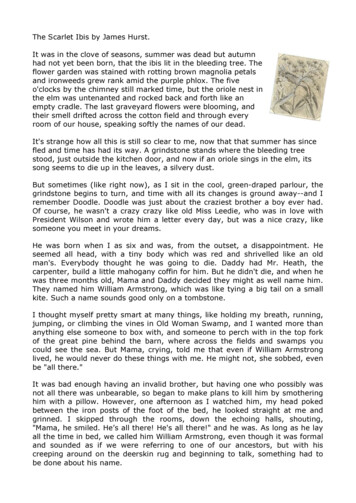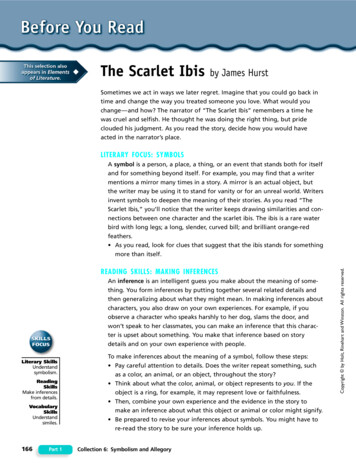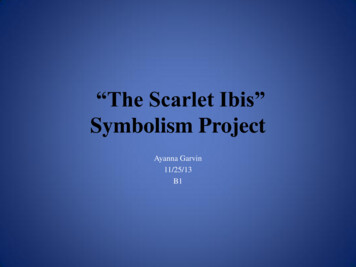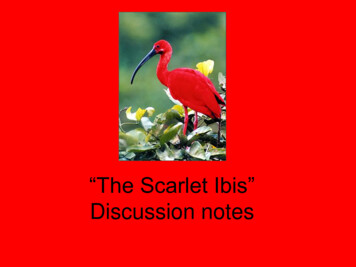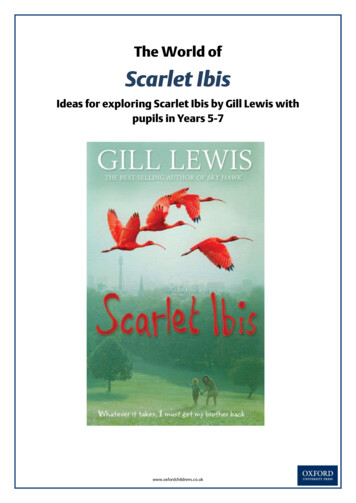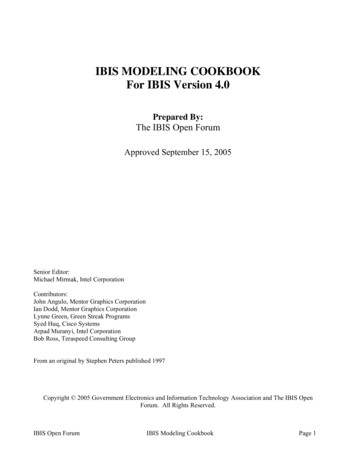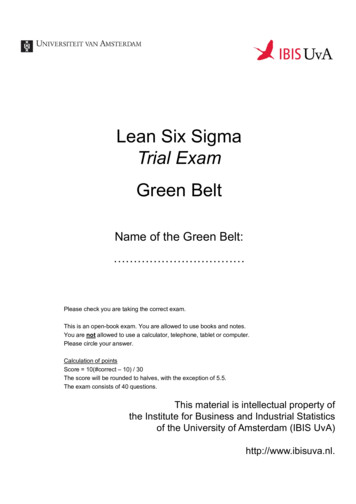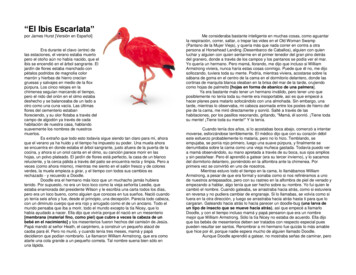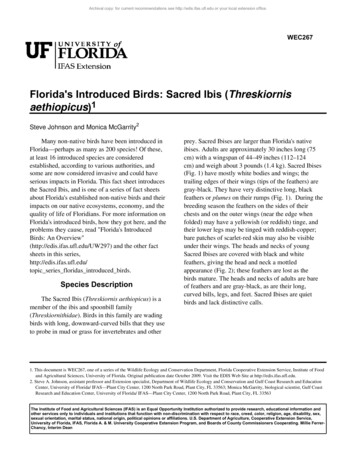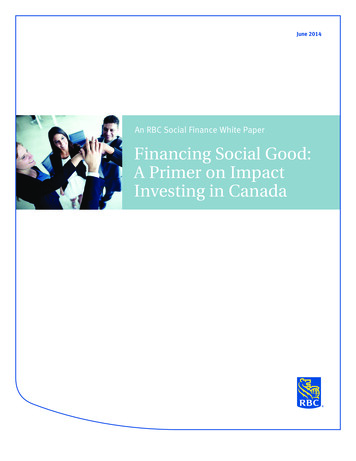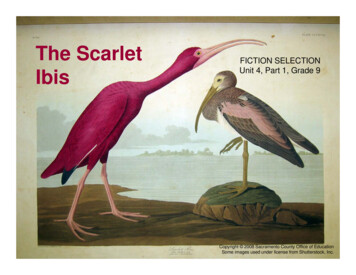
Transcription
The ScarletIbisFICTION SELECTIONUnit 4, Part 1, Grade 9Copyright 2008 Sacramento County Office of EducationSome images used under license from Shutterstock, Inc.
Preparing to ReadConnect to Your Life Expectations are ideasabout what a personis capable of doingor becoming. The narratorof this story has highexpectationsof his younger brother.Copyright 2008 Sacramento County Office of EducationSome images used under license from Shutterstock, Inc.
Preparing to ReadConnect to Your LifeThink about theexpectations thatothers have of you.– Do some peopleexpect greatthings of you?– Do you expect greatthings of yourself?Copyright 2008 Sacramento County Office of EducationSome images used under license from Shutterstock, Inc.
Preparing to ReadConnect to Your Life For each of the following groups of people,assign a number from one to five, with fivebeing the highest, to indicate the levelof expectation they have for you.–––––parentssiblingsfriendsteachers and coachesyourself Who’s expectations are the highest?Copyright 2008 Sacramento County Office of EducationSome images used under license from Shutterstock, Inc.
Preparing to ReadBuild Background“The Scarlet Ibis” isset on a cotton farm inthe South around thetime of World War I –a setting muchlike the one in whichthe author, JamesHurst, grew up.Copyright 2008 Sacramento County Office of EducationSome images used under license from Shutterstock, Inc.
Preparing to ReadBuild BackgroundHurst refers to a number of trees and flowers bythe local names that he learned as a boy.– The “bleeding tree” is a type of pine from whichwhite sap runs like blood when the bark is cut.– “Graveyard flowers” are sweet smelling gardenias,which, because they bloom year after year, areoften planted in cemeteries.– The frayed twigs of the “toothbrush tree” were onceused by people to clean their teeth after eating.Copyright 2008 Sacramento County Office of EducationSome images used under license from Shutterstock, Inc.
Preparing to ReadWords to Know careen infallibility doggedness invalid exotic iridescent heresy precariously imminent reiterateCopyright 2008 Sacramento County Office of EducationSome images used under license from Shutterstock, Inc.
Preparing to ReadFocus Your ReadingA theme is centralidea or messagein a work of fiction.– It is a perception about lifeor human nature that thewriter shares with the reader.Copyright 2008 Sacramento County Office of EducationSome images used under license from Shutterstock, Inc.
Preparing to ReadFocus Your Reading Remember, a themeis not the sameas the subject of a story. Theme is insight aboutthe subject – a statementyou might make, such as:– “Jealousy can be verydestructive.”Copyright 2008 Sacramento County Office of EducationSome images used under license from Shutterstock, Inc.
Preparing to ReadFocus Your Reading A story may have more than one theme. A good way to find a theme is to payattention to the main character of a story.– Does the person go through some sort of change?– What does he or she learn? This might be an insight that the writerwants to share with the reader.Copyright 2008 Sacramento County Office of EducationSome images used under license from Shutterstock, Inc.
Preparing to ReadFocus Your Reading When you look at a numberof details and make a logicalguess about what theymean, you are makingan inference. You might also combineinferences with whatyou already knowand draw a conclusion.Copyright 2008 Sacramento County Office of EducationSome images used under license from Shutterstock, Inc.
Preparing to ReadFocus Your Reading As an active reader of fiction, you constantlymake inferences and conclusions aboutwhat the characters are doing or thinkingand about what motivates them. As you read, jot down two or three thingsyou can infer about its narrator, as wellas any conclusions you come to about him.Copyright 2008 Sacramento County Office of EducationSome images used under license from Shutterstock, Inc.
Reading and AnalyzingActive ReadingDrawing Conclusionsabout the Narrator– The narrator tells what heis “smart” at, what he wantsin a brother, and howhe feels about havingan invalid brother.– What conclusion canyou draw about thenarrator and what he values?Copyright 2008 Sacramento County Office of EducationSome images used under license from Shutterstock, Inc.
Reading and AnalyzingLiterary AnalysisTheme– You are expected torecognize themes withina text and that themesare general observationsabout life or human nature.– What change do you seein the narrator after thebaby smiles and crawls?Copyright 2008 Sacramento County Office of EducationSome images used under license from Shutterstock, Inc.
Reading and AnalyzingReading Skills and StrategiesRecognizing Main Idea– Analyze the text structureto identify the main ideaand supporting detailsin this paragraph.Copyright 2008 Sacramento County Office of EducationSome images used under license from Shutterstock, Inc.
Reading and AnalyzingActive ReadingDrawing Conclusionsabout the Narrator– Why is the narratorwilling to gather flowersfor his brother?– What conclusions canyou draw about thenarrator’s feeling?Copyright 2008 Sacramento County Office of EducationSome images used under license from Shutterstock, Inc.
Reading and AnalyzingActive Reading Predict– What are some predictions you can makebased on what you have read so far? Drawing Conclusions– Why did the narrator sayhe taught his brother to walk?– Why did he cry and what doesthat show about the character?Copyright 2008 Sacramento County Office of EducationSome images used under license from Shutterstock, Inc.
Reading and AnalyzingLiterary AnalysisTheme– How have the narrator’sfeelings changed sincethe story began?– What has thenarrator learned?Copyright 2008 Sacramento County Office of EducationSome images used under license from Shutterstock, Inc.
Reading and AnalyzingActive ReadingDrawing Conclusionsabout the Narrator– Do you think the narratoris being cruel or helpfulto his brother?– What are examples of actsthat are both cruel and helpful?Copyright 2008 Sacramento County Office of EducationSome images used under license from Shutterstock, Inc.
Reading and AnalyzingActive ReadingClarify– What might a “net ofexpectations” be and howmight it trap someone?» Remember that Hansel andGretel, two charactersin a fairy tale, left a trailof crumbs behind whenthey went into the forest.» The trail was supposedto lead them out again.Copyright 2008 Sacramento County Office of EducationSome images used under license from Shutterstock, Inc.
Reading and AnalyzingReading Skills and StrategiesPredicting– What clues suggest thatthe appearance of thebird might be important?Copyright 2008 Sacramento County Office of EducationSome images used under license from Shutterstock, Inc.
Reading and AnalyzingLiterary AnalysisSymbol– It is important torecognize and interpretan important symbol.– In what waysis the bird like doodle?Copyright 2008 Sacramento County Office of EducationSome images used under license from Shutterstock, Inc.
Reading and AnalyzingReading Skills and StrategiesMake Inferences– Why might havethe bird arrivedand then diedin this family’syard?Copyright 2008 Sacramento County Office of EducationSome images used under license from Shutterstock, Inc.
Reading and AnalyzingLiterary AnalysisForeshadowing– What bad luckmight possiblyresult from thedead bird?Copyright 2008 Sacramento County Office of EducationSome images used under license from Shutterstock, Inc.
Reading and AnalyzingLiterary Analysis Understand a Short Story– The crisis of a story is aturning point – the placewhere the conflict is resolved.– Why might a violent stormbe a good signal for astory’s crisis?Copyright 2008 Sacramento County Office of EducationSome images used under license from Shutterstock, Inc.
Reading and AnalyzingActive ReadingDrawing ConclusionsAbout the Narrator– Why did the narratorfirst run away and thenwait for his brother?Copyright 2008 Sacramento County Office of EducationSome images used under license from Shutterstock, Inc.
Reading and AnalyzingLiterary AnalysisTheme– What lessons about lifedid the narrator learn?– How might these lessonsbe expressed as a theme?Copyright 2008 Sacramento County Office of EducationSome images used under license from Shutterstock, Inc.
The Scarlet Ibis Author: Curriculum Companion Subject: McDougal Littell, Grade
